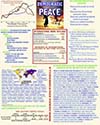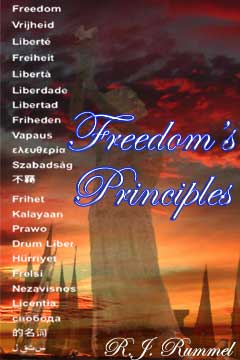[First published September 11, 2005] As a libertarian on domestic policy, I’ve supported, agreed with, and been happy to see much of the policy analyses and recommendations that the CATO Institute has published. It is with sadness, therefore, that I must point out how bad is CATO’s Chapter 2 in their Ninth Annual Ranking of Economic Freedom. Perhaps I can encourage them to be more careful in the future about their publications.
It is more than appropriate to focus a critique on this chapter by the Columbia University Political Scientist, Erik Gartzke , since it is not buried in the report, but given fanfare in CATO’s news release:
Economic freedom is almost 50 times more effective than democracy in restraining nations from going to war, according to the Economic Freedom of the World: 2005 Annual Report, released Thursday by the Cato Institute in conjunction with the Fraser Institute of Canada.
This is not only wrong, but also the Chapter 2 study on which this is based is incompetent. Even the very data Gartzke’s analyzes contradicts the above claim. For example, as I will document below, in his data there are NO (zero) wars between democracies over almost two-centuries. How can economic freedom improve on that, not to mention being 50 times better?
Dean Esmay (blog here) and Colleague had independently pointed me toward the blog by Daniel W. Drezner (here), which favorably reported on this CATO study, repeating not only what CATO says in its press release, but adding Garzke’s conclusion:
The results here suggest that efforts to promote peace in the Middle East and in other regions dominated by autocratic governments through democratization are of particularly questionable worth.
This is the particular danger of the Gartzke’s study, and the reason it was so important beyond CATO’s reputation or it to have been especially careful in including this in their report. It may well lead intelligent and policy-wise analysts and commentators to draw the wrong conclusions about the importance of democratization.
Now, for the details. I’ve gone to the study to see how it arrived at a conclusion that contradicts so much research on the democratic peace. It is here. First, some nitpicking. It is wrong to say, as Drezner does, that: “researchers have found that democracies are less likely to fight each other, while being no less ready to use force generally.” Presumably, the “no less ready” refers to nondemocracies. I published an article on this, “Democracies are less warlike than other regimes,” (here) in which I showed the errors in claims such as Drezner’s, and established empirically that in the 20th Century, democracies engage much less in severe foreign violence than do nondemocracies.
Gartzke says further that: “Democracy is desirable for many reasons but policies that encourage, or even seek to impose, representative government are unlikely to contribute directly to international peace.” There is that misbegotten “impose” again. This is a misunderstanding in what democratization of other countries means. See my blog, “Unchaining Human Rights, Not Imposing Democracy,” on this here.
He also says that, “Developing countries do not benefit from a democratic peace.” Consistently, whether developed or not, developing or not,” the democratic peace of no wars between democracies holds. When there were, depending on the year, 25, 50, 80, or 117 democracies, as of now, the list surely includes all developing democracies as well as those at all levels of development. Yet, no two of them make war on each other. But, he claims that his study finds otherwise. He can only claim this and that democracies are unlikely to contribute to peace by ignoring his own data
So, lets look at his data. These are the Militarized Dispute Data (MID) set on “violence” that is widely available. The particular set he used is for 1816 to 2000. I’ve looked at the original data 1816-1992 in detail, and covered in my own collection the eight additional years to year 2000. (As to the original data set, see Frank W. Wayman’s paper on the “Incidence Of Militarized Disputes Between Liberal States,”) and Daniel M. Jones, Stuart A. Bremer, and J. David Singer, “Militarized Interstate Disputes, 1816-1992: Rationale, Coding Rules, And Empirical Patterns”).
For one, the MID data involves threats, military action (e.g., alerts, mobilization, and hostile movements), and violence short of 1,000 killed. Note that in using these data Gartzke confounds nonviolence with violence, a serious mistake in evaluating the democratic peace since it concerns only violence (some researchers limit this to war, but I do not and consider any combat deaths to be relevant). Still, it may be that his data is capturing enough violence between democracies to be useful.
So how many incidents of violence between democracies are there? In the whole data set, OVER ALMOST TWO CENTURIES, out of 350 cases for all nations (up to 1992), and in the eight additional years, there are ZERO (0) CASES OF WAR, between democracies, and only 3 cases of violence between democracies in which someone was killed. Two of these involved Peru and Ecuador in 1981 and 1984 (26 to 100 killed in the first and 1-25 in the second case of violence). In 1981 Peru was only marginally democratic, as was Ecuador, but less so. This was also true of Peru and Ecuador in 1984. The only other case of violence in the data set was marginally democratic Ecuador (initiator) vs. the U.S. in 1954 in which 1-25 were killed.
Given that this is not the best data set to test the democratic peace against economic freedom, how does he do the test? He uses multiple regression analysis to regress MID on economic freedom, democracy, and a number of other variables. Before evaluating this analysis, I should note from my own study that the correlation between economic freedom and democraticy is high. In fact, they form a common dimension among nations with many other human security and economic variables, and with which democraticy is correlated .83 and economic freedom .85 (table here). Their common , as apart from accidental or random correlation, is therefore, .85 X .83 = .70, which is high. (To better see this relationship, look at the table and figure in my “The Solution to Mass Poverty Blog” here).
This correlation is meaningful for the kind of regression analysis Gartzke did, but he apparently doesn’t know it. A problem in regression analysis is multicollinearity, which is to say moderate or high correlations among the independent variables. If two independent variables are highly correlated they are no longer statistically independent, and the first one entered into the regression, in this case economic freedom, steals that part of the correlation it has with democracy from the dependent variable. Thus, economic freedom is highly significant, while democracy is not. If Gartzke had done two bivariate regressions on his MID data, one with economic freedom and other with democracy as the independent variables, he surely would have found democracy highly significant. (An important statistical point about his use of significance tests — he is not analyzing a sample, but the universe of cases — thus standard significance tests are irrelevant). To protect against multicollinearity in his multiple regression, he should have orthogonalized the independent variables, which is to make them statistically independent of each other. Orthogonalization can be done through factor analysis, and then using the resulting factor scores in the regression.
Thus, his CATO acclaimed results are a result of his misuse of multiple regression and an ignorance of what is in his data. Even then, given his dependent variable, were the regression analysis properly done, I don’ think his data consisting of nonviolent and violent acts would be relevant to what is meant by democratic freedom and violence.
I did my own analysis of democracy, violence, economic development and economic freedom, plus some other human development variables. I asked: Can we predict the level of a nation’s human security (which includes violence) by knowing its level of democracy (analysis here). The final regression is of logviolence factor scores on the factor scores of freedom and human development (thus erasing the problem of multicollinearity), and dummy variables as to whether Moslem or not, or Christian or not (given the purpose of the regression, it did not matter if these two were correlated with the other impendent variables or each other). The regression was excellent, accounting for 74 percent of the variation in violence (with residuals properly dispersed), with democracy (freedom) being far more significant than human development (see Table A.23 here), which includes economic freedom.
How could CATO let such a poor study into their prime report? Was it their libertarian opposition to intervention abroad, even if it is in favor of democracy? Was it their libertarian dislike of the democratic peace, shown by so many libertarian anti-democratic peace articles? Whatever. After reviewing the one study on what I know something about and finding it so poor, it provokes a questioning of their other studies in areas I know less about.
Link of Day
“Doctrine for Joint Nuclear Operations” (just released by the Pentagon)
Deterrence is live and well. This strategic policy report elaborates on American nuclear policy, including that of preemption or FIRST USE, which bush signed off on in 1992. I consider this the most important document on defense policy issued in the last ten years. For those who are bored by such documentation, consider that it was decisions like this about American strategic policy that brought victory in the Cold War, without a world hot war.
Links I Must Share
“Pentagon Revises Nuclear Strike Plan”:
he Pentagon has drafted a revised doctrine for the use of nuclear weapons that envisions commanders requesting presidential approval to use them to preempt an attack by a nation or a terrorist group using weapons of mass destruction. The draft also includes the option of using nuclear arms to destroy known enemy stockpiles of nuclear, biological or chemical weapons.
[RJR: one view of the above report]
“New Pentagon plans envision possible nuclear strikes”:
A Pentagon planning document being updated to reflect the doctrine of pre-emption declared by President Bush in 2002 envisions the use of nuclear weapons to deter terrorists from using weapons of mass destruction against the United States or its allies.
[RJR: Another view]
The Joint Staff hates freedom. What else should I conclude when its staff knowingly place classified material they believe could be harmful to national security on a public webserver?
[A professional arm controller’s view]
Books/articles/statistics



 Posted by rudyrummel
Posted by rudyrummel 






